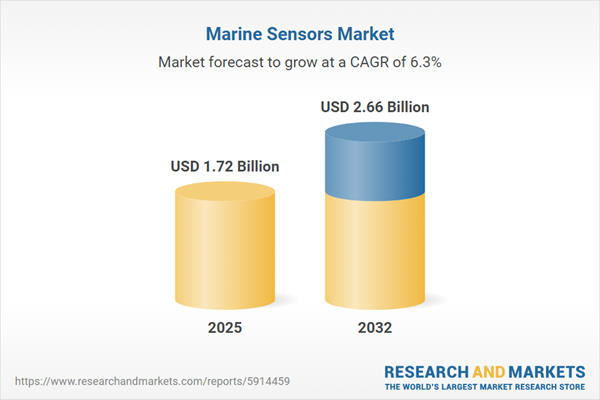Speak directly to the analyst to clarify any post sales queries you may have.
The marine sensors market is entering a pivotal phase, shaped by sophisticated innovations and mounting calls for robust data intelligence in marine environments. Senior decision-makers seeking precise navigational, monitoring, and operational advantages now recognize the transformative potential of sensor solutions in contemporary marine activities.
Marine Sensors Market Snapshot
The marine sensors market grew from USD 1.62 billion in 2024 to USD 1.72 billion in 2025. It is projected to advance at a CAGR of 6.33%, reaching USD 2.66 billion by 2032. This expansion reflects increasing demand across oceanographic research, defense, offshore infrastructure, and environmental monitoring sectors. As real-time data acquisition becomes mission-critical, marine sensor adoption is supported by advances in sensor miniaturization, wireless communication, and materials engineered for harsh marine operating conditions. Suppliers and end-users alike now emphasize competitive positioning through sensor interoperability, predictive insights, and lifecycle support.
Scope & Segmentation
This research report analyzes current trends and forecasts revenues across diverse market dimensions. Key segmentation areas include:
- Product Type: Acoustic sensors, GPS sensors, motion/position/speed sensors, optical sensors, pressure sensors, salinity sensors, smoke detection sensors, temperature sensors
- Connectivity: Wired, wireless
- Functionality: Multi-utility sensors, single-utility sensors
- Applications: Communication and navigation, defense and security, environmental monitoring, ocean exploration, underwater research
- End-User: Commercial entities, defense and government agencies, research institutes
- Sales Channel: Direct sales, distributors
- Regions: Americas (including North America and Latin America), Europe, Middle East, Africa, and Asia-Pacific (including major countries such as United States, Brazil, Germany, China, India, Japan, Australia, and others)
- Companies Profiled: Amphenol Corporation, BAE Systems PLC, Baumer Holding AG, CURTISS-WRIGHT CORPORATION, Danfoss A/S, Dartmouth Ocean Technologies Inc., Furuno Electric Co., Ltd, Garmin Ltd., Gems Sensors, Inc, Hansford Sensors Ltd., Honeywell International Inc., Kongsberg Gruppen ASA, L3Harris Technologies, Inc., Lockheed Martin Corporation, and more
Key Takeaways for Marine Sensors
- Recent advances in materials science and electronics have markedly extended sensor lifespans and operational reliability in challenging marine conditions.
- Integrated sensor arrays bolster real-time analytics for decision-makers in defense, shipping, offshore energy, and research, delivering actionable situational awareness.
- Organizations with established vertical integration and local R&D adapt most effectively to input cost fluctuations and changing geopolitical landscapes.
- Regional shifts in demand reveal that North America prioritizes security and exploration, while Asia-Pacific invests heavily in subsea networks and aquaculture infrastructure.
- Multiple market participants—from legacy instrumentation firms to agile technology start-ups—are leveraging partnerships and modular architectures to maintain innovation leadership.
Impact of 2025 United States Tariffs
2025 U.S. tariffs on select marine sensor subcomponents have introduced elevated cost structures, prompting industry adaptation through alternative sourcing and expanded domestic manufacturing. While some manufacturers leverage government incentives and local partnerships to manage supply chain risks, others with vertically integrated operations demonstrate more resilience. For defense and security customers, willingness to absorb incremental costs supports supply continuity, and distributors are shifting contract terms to phase in price changes. These responses illustrate how tariff-induced changes reshape sourcing approaches and encourage enhanced manufacturing autonomy within the United States market.
Marine Sensors Market Methodology & Data Sources
This analysis integrates primary expert interviews with secondary technical literature for comprehensive, validated insights. Industry leaders, academic specialists, and procurement executives contributed qualitative perspectives, while scholarly journals, regulatory documents, and technical white papers underpinned quantitative assessments. Technology momentum was monitored through patent reviews and engineering specifications, with peer-reviewed findings ensuring interpretive accuracy. This hybrid approach ensures dependable, actionable results for strategic evaluation.
Why This Report Matters for Decision-Makers
- Gain a complete landscape overview and clear analysis of the competitive forces impacting procurement, performance, and innovation strategies within the marine sensors market.
- Identify targeted opportunities for investment and R&D, supported by robust coverage of key technologies and regulatory environments across major regions.
- Access actionable insights for risk mitigation and adaptive planning with segmentation frameworks and regional breakdowns that align with your organization’s strategic objectives.
Conclusion
Senior decision-makers benefit from this report’s thorough analysis of market drivers, technological shifts, and evolving strategic frameworks. Prepare for the next phase of growth by aligning organizational priorities with the trends shaping global marine sensor adoption.
Additional Product Information:
- Purchase of this report includes 1 year online access with quarterly updates.
- This report can be updated on request. Please contact our Customer Experience team using the Ask a Question widget on our website.
Table of Contents
3. Executive Summary
4. Market Overview
7. Cumulative Impact of Artificial Intelligence 2025
Companies Mentioned
The companies profiled in this Marine Sensors market report include:- Amphenol Corporation
- BAE Systems PLC
- Baumer Holding AG
- CODAR Ocean Sensors, Ltd.
- Curtiss-Wright Corporation
- Cyclops Marine Limited
- Danfoss A/S
- Dartmouth Ocean Technologies Inc.
- Endress+Hauser AG
- Furuno Electric Co., Ltd
- Garmin Ltd.
- Gems Sensors, Inc
- Gill Sensors & Controls Limited
- Hansford Sensors Ltd.
- Honeywell International Inc.
- In-Situ Inc. by The Boeing Company
- Kongsberg Gruppen ASA
- L3Harris Technologies, Inc.
- Lockheed Martin Corporation
- Micro-Air, LLC by Innovative Motion Technologies Company
- Miros by Aircontact Group AS
- Nantong Saiyang Electronics Co.,Ltd
- NKE Marine Electronics
- Nortek Group
- NORTHROP GRUMMAN CORPORATION
- RTX Corporation
- SBG Systems
- Sea-Bird Scientific by Veralto
- Senmatic A/S
- Signet Marine Inc.
- Siren Marine, LLC by Yamaha Motor Co., Ltd.
- Sonardyne International Ltd
- TE Connectivity Corporation
- Teledyne Technologies Incorporated
- Trensor, LLC
- Xylem Inc.
Table Information
| Report Attribute | Details |
|---|---|
| No. of Pages | 197 |
| Published | November 2025 |
| Forecast Period | 2025 - 2032 |
| Estimated Market Value ( USD | $ 1.72 Billion |
| Forecasted Market Value ( USD | $ 2.66 Billion |
| Compound Annual Growth Rate | 6.3% |
| Regions Covered | Global |
| No. of Companies Mentioned | 37 |









